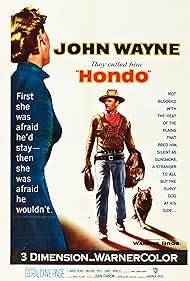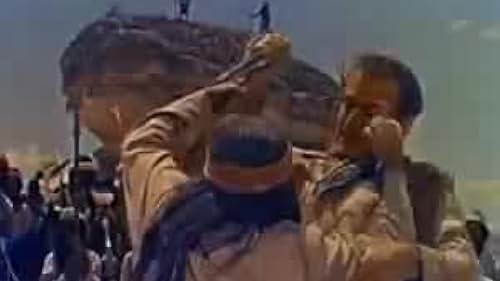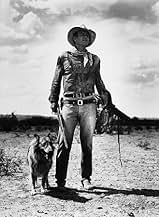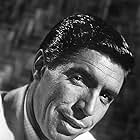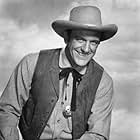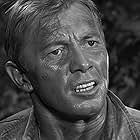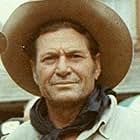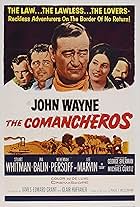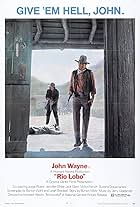Army dispatch rider Hondo Lane discovers a woman and young son living in the midst of warring Apaches and becomes their protector.Army dispatch rider Hondo Lane discovers a woman and young son living in the midst of warring Apaches and becomes their protector.Army dispatch rider Hondo Lane discovers a woman and young son living in the midst of warring Apaches and becomes their protector.
- Nominated for 2 Oscars
- 2 nominations total
- Director
- Writers
- All cast & crew
- Production, box office & more at IMDbPro
Storyline
Did you know
- TriviaMichael Pate who plays the Indian chief was also in real life an expert in Old West Military procedure. He told later that the Indian attack in the movie was not realistic at all, because Indians were experts in guerrilla warfare and would never have been trapped in an arroyo by the U.S. Army.
- GoofsWhen Hondo grabs Johnny to throw him in the water he is wearing his Indian necklace. When Hondo picks him up and throws him he no longer has it on.
- Quotes
Hondo Lane: A man oughta do what he thinks is best.
- Crazy creditsDan Rowan as one of the soldiers underneath a wagon shot during the final attack.
- Alternate versionsIn 1991 cable channel TNT showed a special 3-D version of the film. Grocery stores gave away John Wayne 3D glasses for the promotion.
- ConnectionsFeatured in The Shootist (1976)
Featured review
In the 5/1/88 episode of "Married With Children," the one entitled "All in the Family," paterfamilias schlemiel Al Bundy tries--unsuccessfully, of course--to catch his favorite movie, the 1953 John Wayne vehicle "Hondo," during an ill-timed invasion of his wife's relations. Undeterred, six years later, Bundy, in the 5/8/94 episode "Assault and Batteries," again tries to catch his favorite flick, and with just as little luck. And back when, any Wayne fan could easily sympathize with the hapless sadsack. "Hondo," along with such Wayne films as "Island in the Sky" and "The High and the Mighty," was extremely difficult to see for many years: never shown on television, rarely screened in revival theatres and largely unavailable for home viewing. What Al wouldn't have given for today's current DVD from Paramount, featuring a stunning print and over an hour's worth of fascinating extras! Today, it is a simple matter to view "Hondo" at any time, and appreciate it for the highly impressive Western that it is.
In the film--based on the early Louis L'Amour short story "The Gift of Cochise"--Wayne plays a part-Apache cavalry scout named Hondo Lane. When we first encounter him, in the year 1870, the footsore Hondo stumbles onto the New Mexico homestead of Mrs. Angie Lowe (Geraldine Page, the renowned NYC stage actress, here in her very first film) and her young son Johnny (appealingly played by child actor Lee Aaker). Hondo purchases a horse from Mrs. Lowe, is given a place to sleep after being provided with food and water, and, after learning that Mr. Lowe is something of a disreputable, absentee husband, helps the plain-looking mother with her chores. Trouble looms, however, when, after returning to his cavalry unit, Hondo has a run-in with a lowlife scumball whom he is forced to kill...and who turns out to be none other than Mr. Lowe! Already half in love with the woman whose husband he has just shot down, Hondo returns to the Lowe homestead with a double mission: to tell the mother and son the news of what has just transpired, and to protect the pair from an uprising of (justifiably) angry Apaches, who have recently gone on a murderous warpath....
Truth to tell, "Hondo" strikes this viewer as an unusual choice for Al Bundy's favorite John Wayne film, what with its emphasis on romance and courtship (indeed, for the first 25 minutes of the picture, Hondo and Mrs. Lowe do nothing but talk and grow close to each other), as well as father/son ties (then again, young Johnny is a lot more cute and loving than Bud Bundy could ever hope to be; perhaps Al saw in Johnny the son that he never had?). Still, the film is understandably captivating for any viewer, and boasts any number of sterling attributes. For one thing, it is a film of great visual beauty; the desert terrain outside Ciudad Camargo (Chihuahua State, Mexico), where the movie was largely shot, is often breathtaking, and just about every outdoor scene seems to be adorned by stunning cloud formations. The film also boasts several wonderful sequences, including Hondo fleeing from the Apaches on horseback, Hondo engaging in a knife fight with an Apache on top of a mesa, and, most memorably, Hondo "teaching" Johnny how to swim. This was Wayne's first Western in three years, since 1950's "Rio Grande," and fans would have to wait another three years to see him in another (arguably, Wayne's best: 1956's "The Searchers"), but he is simply terrific here as Hondo, the self-reliant loner whose creed--"I let people do what they want to do"--is one that we would all do well to emulate. Page has an interesting chemistry with him, and it is wonderful to see the homely mother blossom and grow prettier as the film proceeds, as she and Hondo fall very much in love. Page deservedly garnered an Oscar nomination (her first of eight) for her work here, ultimately losing the Best Supporting Actress statuette for that year to Donna Reed, for her fine work in "From Here to Eternity." Kudos must also be given to Australian actor Michael Pate, who would go on, 14 years later, to reprise his role as the Apache chief Vittoro in the short-lived ABC TV program "Hondo," starring Ralph Taeger (I know, I know...who?) in the title role, as well as young Aaker for his winning performance. Likewise, the great character actors Ward Bond, Leo Gordon and James Arness (two years pre-"Gunsmoke") all manage to make the most of their small but crucial roles.
"Hondo" also features fine work behind the camera. With solid direction by John Farrow (husband of Maureen O'Sullivan and father of Mia, and who would go on to work with Wayne in 1955's "The Sea Chase"), in addition to uncredited direction by the legendary John Ford of the climactic battle sequence; a winning script from Wayne's favorite screenwriter, James Edward Grant; and a lovely theme song and pounding incidental music from Emil Newman and Hugo W. Friedhofer, the picture really is a fortuitous merging of great talents. Though shot in 3-D, the film is not overly reliant on in-your-face stunts to keep the viewer entertained; indeed, other than a few knife thrusts into the camera, there are few such tricks to speak of, and the film looks and works just fine in 2-D (apparently, "Hondo" was only shown in 3-D during the first week of its initial run, anyway!). The bottom line is that while "Hondo" may not be the Wayne masterpiece that "Stagecoach," "Red River" and "The Searchers" are, it yet remains a very solid, artfully made and highly entertaining picture. As it turns out, Al Bundy had good reason to rush home and turn on his television set....
In the film--based on the early Louis L'Amour short story "The Gift of Cochise"--Wayne plays a part-Apache cavalry scout named Hondo Lane. When we first encounter him, in the year 1870, the footsore Hondo stumbles onto the New Mexico homestead of Mrs. Angie Lowe (Geraldine Page, the renowned NYC stage actress, here in her very first film) and her young son Johnny (appealingly played by child actor Lee Aaker). Hondo purchases a horse from Mrs. Lowe, is given a place to sleep after being provided with food and water, and, after learning that Mr. Lowe is something of a disreputable, absentee husband, helps the plain-looking mother with her chores. Trouble looms, however, when, after returning to his cavalry unit, Hondo has a run-in with a lowlife scumball whom he is forced to kill...and who turns out to be none other than Mr. Lowe! Already half in love with the woman whose husband he has just shot down, Hondo returns to the Lowe homestead with a double mission: to tell the mother and son the news of what has just transpired, and to protect the pair from an uprising of (justifiably) angry Apaches, who have recently gone on a murderous warpath....
Truth to tell, "Hondo" strikes this viewer as an unusual choice for Al Bundy's favorite John Wayne film, what with its emphasis on romance and courtship (indeed, for the first 25 minutes of the picture, Hondo and Mrs. Lowe do nothing but talk and grow close to each other), as well as father/son ties (then again, young Johnny is a lot more cute and loving than Bud Bundy could ever hope to be; perhaps Al saw in Johnny the son that he never had?). Still, the film is understandably captivating for any viewer, and boasts any number of sterling attributes. For one thing, it is a film of great visual beauty; the desert terrain outside Ciudad Camargo (Chihuahua State, Mexico), where the movie was largely shot, is often breathtaking, and just about every outdoor scene seems to be adorned by stunning cloud formations. The film also boasts several wonderful sequences, including Hondo fleeing from the Apaches on horseback, Hondo engaging in a knife fight with an Apache on top of a mesa, and, most memorably, Hondo "teaching" Johnny how to swim. This was Wayne's first Western in three years, since 1950's "Rio Grande," and fans would have to wait another three years to see him in another (arguably, Wayne's best: 1956's "The Searchers"), but he is simply terrific here as Hondo, the self-reliant loner whose creed--"I let people do what they want to do"--is one that we would all do well to emulate. Page has an interesting chemistry with him, and it is wonderful to see the homely mother blossom and grow prettier as the film proceeds, as she and Hondo fall very much in love. Page deservedly garnered an Oscar nomination (her first of eight) for her work here, ultimately losing the Best Supporting Actress statuette for that year to Donna Reed, for her fine work in "From Here to Eternity." Kudos must also be given to Australian actor Michael Pate, who would go on, 14 years later, to reprise his role as the Apache chief Vittoro in the short-lived ABC TV program "Hondo," starring Ralph Taeger (I know, I know...who?) in the title role, as well as young Aaker for his winning performance. Likewise, the great character actors Ward Bond, Leo Gordon and James Arness (two years pre-"Gunsmoke") all manage to make the most of their small but crucial roles.
"Hondo" also features fine work behind the camera. With solid direction by John Farrow (husband of Maureen O'Sullivan and father of Mia, and who would go on to work with Wayne in 1955's "The Sea Chase"), in addition to uncredited direction by the legendary John Ford of the climactic battle sequence; a winning script from Wayne's favorite screenwriter, James Edward Grant; and a lovely theme song and pounding incidental music from Emil Newman and Hugo W. Friedhofer, the picture really is a fortuitous merging of great talents. Though shot in 3-D, the film is not overly reliant on in-your-face stunts to keep the viewer entertained; indeed, other than a few knife thrusts into the camera, there are few such tricks to speak of, and the film looks and works just fine in 2-D (apparently, "Hondo" was only shown in 3-D during the first week of its initial run, anyway!). The bottom line is that while "Hondo" may not be the Wayne masterpiece that "Stagecoach," "Red River" and "The Searchers" are, it yet remains a very solid, artfully made and highly entertaining picture. As it turns out, Al Bundy had good reason to rush home and turn on his television set....
- How long is Hondo?Powered by Alexa
Details
Box office
- Budget
- $3,000,000 (estimated)
- Runtime1 hour 23 minutes
- Aspect ratio
- 1.85 : 1
Contribute to this page
Suggest an edit or add missing content

